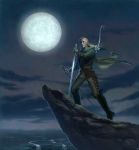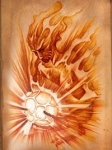 Reader deep thought: Well, “You’ve got mail!” was probably the alert most in the Blessed Realm could only dream of hearing forevermore. If there was any notion of the Valar going native with their penchant of looking like the locals, the opening preamble proved the Valar were superior beings not born of Arda. The more surprising revelation must be the potential of Fëanor. Got to wonder, why a Noldor? Why not a Vanyar? Also, the Sun and the Moon!
Reader deep thought: Well, “You’ve got mail!” was probably the alert most in the Blessed Realm could only dream of hearing forevermore. If there was any notion of the Valar going native with their penchant of looking like the locals, the opening preamble proved the Valar were superior beings not born of Arda. The more surprising revelation must be the potential of Fëanor. Got to wonder, why a Noldor? Why not a Vanyar? Also, the Sun and the Moon!
“… And they mourned not more for the death of the Trees than for the marring of Fëanor: of the works of Melkor one of the most evil. For Fëanor was made the mightiest in all parts of body and mind, in valour, in endurance, in beauty, in understanding, in skill, in strength and in subtlety alike, of all the Children of Ilúvatar, and a bright flame was in him. The works of wonder for the glory of Arda that he might otherwise have wrought only Manwë might in some measure conceive. And it was told by the Vanyar who held vigil with the Valar that when the messengers declared to Manwë the answers of Fëanor to his heralds, Manwë wept and bowed his head….”
SUMMARY NOTES
Fëanor, oh Fëanor! If only. Because he vowed the Noldor should do deeds that would live in song forever, Manwë accommodating sealed the deal for him.
‘So shall it be! Dear-bought those songs shall be accounted, and yet shall be well-bought. For the price could be no other. Thus even as Eru spoke to us shall beauty not before conceived be brought into Eä, and evil yet be good to have been.’
But Mandos said: ‘And yet remain evil. To me shall Fëanor come soon.’
Fëanor should have paid attention. The last time Mandos did his Mr. Brevity Cryptical act, Finwë was brought down.
Only when the Noldor were done getting to Middle-earth, did the Valar set to work tidying up. By the combined effort of Nienna’s tears and Yavanna’s song, finally “Telperion bore at last upon a leafless  bough one great flower of silver, and Laurelin a single fruit of gold.”
bough one great flower of silver, and Laurelin a single fruit of gold.”
Then the Trees truly died, “their lifeless stems stand yet in Valinor, a memorial of vanished joy.” But the flower and the fruit Yavanna turned over to Aulë. Manwë hallowed them, while Aulë and his people made vessels to hold them and preserve their radiance”, as was recorded in the Narsilion, the Song of the Sun and Moon.
Varda set the vessels “nearer to Arda; and she gave them power to traverse the lower regions of Ilmen, and set them to voyage upon appointed courses above the girdle of the Earth from the West unto the East and to return.” As lamps, nearer to Arda than the stars, they would outshine the stars, and light to hinder the fell deeds o Melkor, and perhaps illuminate the way for all, even the Avari, the wayward Noldor, and the Aftercomers yet to appear.
And it is said indeed that, even as the Valar made war upon Melkor for the sake of the Quendi, so now for that time they forbore for the sake of the Hildor, the Aftercomers, the younger Children of Ilúvatar. For so grievous had been the hurts of Middle-earth in the war upon Utumno that the Valar feared lest even worse should now befall; whereas the Hildor should be mortal, and weaker than the Quendi to withstand fear and tumult. Moreover it was not revealed to Manwë where the beginning of Men should be, north, south, or east. Therefore the Valar sent forth light, but made strong the land of their dwelling.
So where the Valar waged war upon Melkor for the Elves’ sake, they now hold back for the Men’s.
Isil the Sheen the Vanyar of old named the Moon, flower of Telperion in Valinor; and Anar the Fire-golden, fruit of Laurelin, they named the Sun. But the Noldor named them also Rána, the Wayward, and Vása, the Heart of Fire, that awakens and consumes; for the Sun was set as a sign for the awakening of Men and the waning of the Elves, but the Moon cherishes their memory.
Both steersmen of the vessels came from the Maiar.
 Tilion volunteered to be Isil’s steersman. A hunter under Oromë, wielding a silver bow, “he was a lover of silver, and when he would rest he forsook the woods of Oromë, and going into Lórien he lay in dream by the pools of Estë, in Telperion’s flickering beams.”
Tilion volunteered to be Isil’s steersman. A hunter under Oromë, wielding a silver bow, “he was a lover of silver, and when he would rest he forsook the woods of Oromë, and going into Lórien he lay in dream by the pools of Estë, in Telperion’s flickering beams.”
 On the other hand, Arien was chosen to steer Anar, for in the days of the Trees she “had tended the golden flowers in the gardens of Vána, and watered them with the bright dews of Laurelin.” She was also mightier than Tilion, and did not fear “the heats of Laurelin, and was unhurt by them, being from the beginning a spirit of fire, whom Melkor had not deceived nor drawn to his service. Too bright were the eyes of Arien for even the Eldar to look on, and leaving Valinor she forsook the form and raiment which like the Valar she had worn there, and she was as a naked flame, terrible in the fullness of her splendour.”
On the other hand, Arien was chosen to steer Anar, for in the days of the Trees she “had tended the golden flowers in the gardens of Vána, and watered them with the bright dews of Laurelin.” She was also mightier than Tilion, and did not fear “the heats of Laurelin, and was unhurt by them, being from the beginning a spirit of fire, whom Melkor had not deceived nor drawn to his service. Too bright were the eyes of Arien for even the Eldar to look on, and leaving Valinor she forsook the form and raiment which like the Valar she had worn there, and she was as a naked flame, terrible in the fullness of her splendour.”
Isil’s circuit in the realm of the stars started first, traversing West to East as designed by Varda. “The elder of the new lights, as was Telperion of the Trees,” the Moonlight of Isil quickened many things that Yavanna made and put to sleep, astounding Morgoth’s minions and Elves of the Outer Lands, in polarising ways. The Moon also lighted Fingolfin’s way, as he marched into Middle-earth, “and the shadows of his host went long and black before them.”
Seven circuits later, Anar arose, “and the first dawn of the Sun was like a great fire upon the towers of the Pelóri: the clouds of Middle-earth were kindled, and there was heard the sound of many waterfalls. Then indeed Morgoth was dismayed, and he descended into the uttermost depths of Angband, and withdrew his servants, sending forth great reek and dark cloud to hide his land from the light of the Daystar.” The First Age of the Years of the Sun (and Moon) had begun.
Varda’s design was for the paths of Isil and Anar to complement each other, and that only one should be over Arda at any one time, except when at opposite ends of their circuits, their light mingle, as did the Two Trees.
Thus the first of the new days were reckoned after the manner of the Trees, from the mingling of the lights when Arien and Tilion passed in their courses, above the middle of the Earth.
But, boys will be boys. Tilion “was wayward and uncertain in speed, and held not to his appointed path; and he sought to come near to Arien, being drawn by her splendour, though the flame of Anar scorched him, and the island of the Moon was darkened.” This caused generic insomnia, and the stars’ light was obscured by the ever presence of one of the vessels. At the behest of Lórien and Estë, Varda adjusted her concept, to allow for somnolence.
…. Anar rested therefore a while in Valinor, lying upon the cool bosom of the Outer Sea; and Evening, the time of the descent and resting of the Sun, was the hour of greatest light and joy in Aman. But soon the Sun was drawn down by the servants of Ulmo, and went then in haste under the Earth, and so came unseen to the east and there mounted the heaven again, lest night be overlong and evil walk under the Moon. But by Anar the waters of the Outer Sea were made hot and glowed with coloured fire, and Valinor had light for a while after the passing of Arien. Yet as she journeyed under the Earth and drew towards the east the glow faded and Valinor was dim, and the Valar mourned then most for the death of Laurelin. At dawn the shadows of the Mountains of Defence lay heavy on the Blessed Realm.
So Tilion was to follow the same routine, except his shift pattern was inverse to Arien’s. Still, he “Tilion went with uncertain pace, as yet he goes, and was still drawn towards Arien, as he shall ever be; so that often both may be seen above the Earth together, or at times it will chance that he comes so nigh that his shadow cuts off her brightness and there is a darkness amid the day.”
And Tilion’s inconsistency was another reason for the Valar to reckon time by Anar’s rising, for he “tarried seldom in Valinor, but more often would pass swiftly over the western land, over Avathar, or Araman, or Valinor, and plunge in the chasm beyond the Outer Sea, pursuing his way alone amid the grots and caverns at the roots of Arda. There he would often wander long, and late would return.”
Morgoth hated both the Sun and the Moon. He assailed Tilion with spirits in Illmen, unsuccessfully. But the Sun he hid from, for “Arien Morgoth feared with a great fear, but dared not come nigh her, having indeed no longer the power; for as he grew in malice, and sent forth from himself the evil that he conceived in lies and creatures of wickedness, his might passed into them and was dispersed, and he himself became ever more bound to the earth, unwilling to issue from his dark strongholds. With shadows he hid himself and his servants from Arien, the glance of whose eyes they could not long endure; and the lands near his dwelling were shrouded in fumes and great clouds.”
Despite his assault on Tilion, the Valar hesitate to retaliate, remembering the War of the Powers and all that it wrought. But informed by the memory of Almaren’s destruction, they set about fortification works: the Pelóri were raised to dreadful heights in the east, north, and south, with rock walls so sheer no one can hope to scale them. Only the pass of Calacirya remained open, in consideration of the Elves yet in the West, and also the Valar were mindful that “for all those of elven-race, even the Vanyar and Ingwë their lord, must breathe at times the outer air and the wind that comes over the sea from the lands of their birth”. Nonetheless, a “sleepless watch” was set on the Pelóri:
But in the Calacirya they set strong towers and many sentinels, and at its issue upon the plains of Valmar a host was encamped, so that neither bird nor beast nor elf nor man, nor any creature beside that dwelt in Middle-earth, could pass that leaguer.
Seaward, the Valar created the “Nurtalë Valinóreva”, the “Enchanted Isles”, about which “all the seas about them were filled with shadows and bewilderment. And these isles were strung as a net in the Shadowy Seas from the north to the south, before Tol Eressëa, the Lonely Isle, is reached by one sailing west.” Clearly, the Valar meant for the Blessed Realm to no longer be gained by just anyone, thanks to the Noldor. And even if a crafty mariner made it to this part of the sea, he would soon grow to hate even the sea. And any who managed to reach one and set foot there would slumber until the Change of the World.
Thus it was that as Mandos foretold to them in Araman the Blessed Realm was shut against the Noldor; and of the many messengers that in after days sailed into the West none came ever to Valinor—save one only: the mightiest mariner of song.
In short, the Valar’s response to the reality of Isil/Tilion being waylaid, and the possibility of escalation, was to shut themselves away and just keep Valinor safe. Way to leave the playground vulnerable and encourage bullies.
And clearly, correspondence was going to be a self-inflicted challenge going forward.
(Relevance: read-along schedule)

The mightiest mariner of song?! But who could they mean? This is one of the “filler” chapters (in my mind). I always forget about, even though some pretty important stuff happens in it. It’s clean up and set up, and that’s probably why it feels this way. The clean up obviously had to happen, and the set up is setting up things that we easily remember. It’s not actually filler, but it’s not Turin, either.
LikeLike
Da-Da-Dum-Dum-Duuuuuuuum Yeah, who could the fabled sailor be? 😉
You’re right, it’s not Turin, but Turin depresses me. I’m having second thoughts on picking up The Children Of Hurin now, to be honest.
But, you know, the interesting thing about the Silm is, there is a method to the the madness. I’ve not quite figured it all out yet, but I think there’s a pattern, a path through these sometimes disparate chapters. This tumblr post maps out a path, helpfully graphical too. I’ve yet to compare it with my own findings, but I do plan to do something like a storyline guide after my chapter notations are done, and may use it for some prompters. (Hopefully, the old noggin retains the vital bits needed to connect the dots).
LikeLike
I cannot stress this enough – pick it up! Pick up and read the Children of Hurin. Super a lot. If you want an extra wonderful treat (and you do), find the audio book of Christopher Lee reading it.
I really like the Silm guide. It’s probably as good as we’re going to get until someone actually makes an annotated volume (like the Readers Companion that Hammond & Scull did for LotR). We desperately need that.
Whenever I finish the LotR project, I’m definitely probably moving onto the Silm. One page per post. It’ll take me a couple of years, but that’s okay. It’ll allow me to dig into the drafts, changes, Lays, and history a bit.
But super serious – read Children of Hurin.
LikeLike
“If you want an extra wonderful treat (and you do), find the audio book of Christopher Lee reading it.”
Now that sounds like really sumptious! makes note
CoH is on my reading schedule. Right after the UT. So Silm-LotR-UT. Actually, I am quite excited the thought of tackling it, being the first new Tolkien read for me in an Age. 🙂 Thanks for the endorsement/rec, I will persevere, and keep to the straight and narrow!
Looking forward to your Silmmie project! 😀
LikeLike
I think I would do Hurin first and then skip most of the Hurin chapter in UT (tons of overlap). Maybe read the notes because notes are awesome. But that’s just me. Read it when you like. It’s all good.
LikeLike
Thanks for the tip. I’ll keep that in mind when i get to the UT.
LikeLike